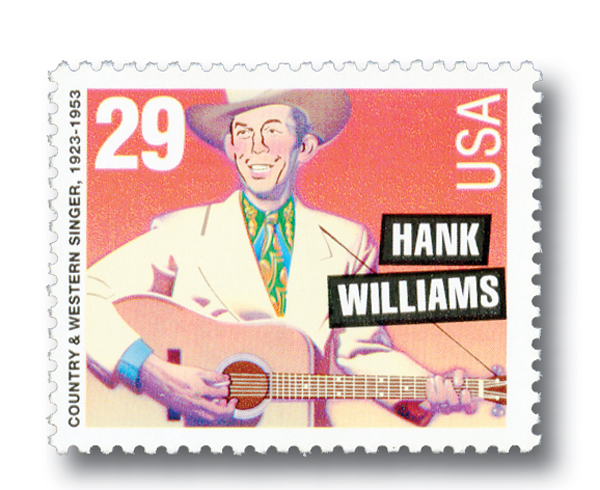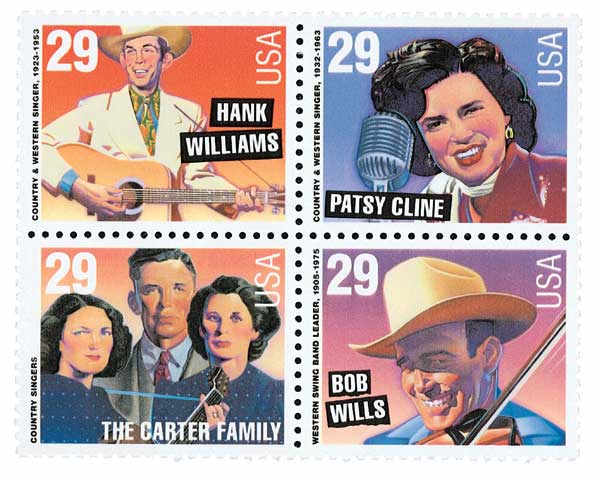
# 2723 PB - 1993 29c Legends of American Music: Hank Williams
29¢ Hank Williams
Legends of American Music
City: Nashville, TN
Quantity: 150,000,000 (estimate)
Printed By: Stamp Venturers
Printing Method: Photogravure
Perforations: 10.15 x 10.25
Color: Multicolored
According to Youngblood, Stamp Venturers (the printing company responsible for the production of the stamps) had ordered a new perforation machine for the Hank Williams stamps, but the USPS unexpectedly moved up the stamp's release date. The new perforation machine had not yet arrived, so they perforated a small quantity (about 2,071,360) with their older perforation machine. These were the stamps delivered to post offices on the First Day of Issue. When the new perforation machine arrived, the remaining quantity of stamps were perforated using that, giving them a different gauge than the others.
Both US #2723 and 2723A have a neat story, making them fun to collect today.
Happy Birthday, Hank Williams
His father suffered an injury during World War I and went on to spend much of Williams’s childhood in the hospital, leaving his mother to work and raise the children on her own. They moved several times and she opened a string of boarding houses, but managed to find some stability, even during the Great Depression.

Williams taught himself to play guitar when he was eight, but also learned a lot from street performer Rufus “Tee-Tot” Payne. In 1937, Williams adopted the name Hank. That year he also entered a talent show and won first prize for his first original song, “WPA Blues.”

In evenings and on weekends, Williams played his guitar on the street in front of the local radio station. The station’s producers enjoyed his performances and learned of his talent show win, so they invited him to occasionally perform on air. Over time, an increasing number of listeners called in requesting “the singing kid,” so the station gave him his own 15-minute show twice a week. The show’s success led him to start his own band, the Drifting Cowboys, at the age of 14. Over the next few years, the band played clubs and parties throughout central and southern Alabama. Williams then dropped out of school in 1939 so they could travel even further for performances.

When the US entered World War II, Williams’s band was drafted, but he was deferred due to a back injury. His alcoholism began causing problems – his band replacements refused to play with him and the radio station fired him. When he met one of his idols Roy Acuff, he warned Williams about the dangers of alcohol abuse. Acuff told him, “You’ve got a million-dollar talent son, but a ten-cent brain.”

For the rest of the war, Williams worked for a shipbuilding company. He also sang in bars for soldiers and met and married Audrey Sheppard. By 1945, he was back to performing at the Montgomery radio station, performing new songs he wrote every week. He then published a songbook, which earned him significant attention as a songwriter. In 1946, he met Fred Rose of Acuff-Rose Music and sang a song for him, earning a six-song contract with Sterling Records.

In 1947, Williams moved to Nashville – the recording and broadcasting center of country music. There he introduced the country music world to a style that would later become known as “rockabilly” – a precursor to rock ‘n’ roll blended with a country flair. With hits such as “Move It On Over” and “Honky Tonkin’” he gained instant popularity. His performances on the Grand Ole Opry program, broadcast nationally every Saturday night, catapulted him to stardom.

Although Williams’ style changed country and western music forever, his lasting legacy may be his lyrics. He wrote literally hundreds of hits, offering country music some of its most enduring songs, including “Cold, Cold Heart”, “Jambalaya”, and “Ramblin’ Man.” “Your Cheatin’ Heart” has been recorded by at least fifty people.

Williams had long suffered from an undiagnosed case of spina bifida occulta, which left him in pain for most of his life. This plus an injury in 1951, led him to abuse alcohol and prescription drugs. He died on January 1, 1953, while enroute to a New Year’s Day concert at the age of 29. According to the autopsy, it was because of an “insufficiency of the right ventricle of the heart.”
Despite his short career, Williams is considered the “King of Country Music.” During his lifetime, he had 11 number one country hits, plus many others that placed in the top ten. Alabama celebrates Hand Williams on September 21 and he received a star on the Hollywood Walk of Fame in 1960. Today Williams’ son Hank Williams Jr., who is also a country singer and composer, carries on his father’s legacy.
Click here for more from the Hank Williams website.
29¢ Hank Williams
Legends of American Music
City: Nashville, TN
Quantity: 150,000,000 (estimate)
Printed By: Stamp Venturers
Printing Method: Photogravure
Perforations: 10.15 x 10.25
Color: Multicolored
According to Youngblood, Stamp Venturers (the printing company responsible for the production of the stamps) had ordered a new perforation machine for the Hank Williams stamps, but the USPS unexpectedly moved up the stamp's release date. The new perforation machine had not yet arrived, so they perforated a small quantity (about 2,071,360) with their older perforation machine. These were the stamps delivered to post offices on the First Day of Issue. When the new perforation machine arrived, the remaining quantity of stamps were perforated using that, giving them a different gauge than the others.
Both US #2723 and 2723A have a neat story, making them fun to collect today.
Happy Birthday, Hank Williams
His father suffered an injury during World War I and went on to spend much of Williams’s childhood in the hospital, leaving his mother to work and raise the children on her own. They moved several times and she opened a string of boarding houses, but managed to find some stability, even during the Great Depression.

Williams taught himself to play guitar when he was eight, but also learned a lot from street performer Rufus “Tee-Tot” Payne. In 1937, Williams adopted the name Hank. That year he also entered a talent show and won first prize for his first original song, “WPA Blues.”

In evenings and on weekends, Williams played his guitar on the street in front of the local radio station. The station’s producers enjoyed his performances and learned of his talent show win, so they invited him to occasionally perform on air. Over time, an increasing number of listeners called in requesting “the singing kid,” so the station gave him his own 15-minute show twice a week. The show’s success led him to start his own band, the Drifting Cowboys, at the age of 14. Over the next few years, the band played clubs and parties throughout central and southern Alabama. Williams then dropped out of school in 1939 so they could travel even further for performances.

When the US entered World War II, Williams’s band was drafted, but he was deferred due to a back injury. His alcoholism began causing problems – his band replacements refused to play with him and the radio station fired him. When he met one of his idols Roy Acuff, he warned Williams about the dangers of alcohol abuse. Acuff told him, “You’ve got a million-dollar talent son, but a ten-cent brain.”

For the rest of the war, Williams worked for a shipbuilding company. He also sang in bars for soldiers and met and married Audrey Sheppard. By 1945, he was back to performing at the Montgomery radio station, performing new songs he wrote every week. He then published a songbook, which earned him significant attention as a songwriter. In 1946, he met Fred Rose of Acuff-Rose Music and sang a song for him, earning a six-song contract with Sterling Records.

In 1947, Williams moved to Nashville – the recording and broadcasting center of country music. There he introduced the country music world to a style that would later become known as “rockabilly” – a precursor to rock ‘n’ roll blended with a country flair. With hits such as “Move It On Over” and “Honky Tonkin’” he gained instant popularity. His performances on the Grand Ole Opry program, broadcast nationally every Saturday night, catapulted him to stardom.

Although Williams’ style changed country and western music forever, his lasting legacy may be his lyrics. He wrote literally hundreds of hits, offering country music some of its most enduring songs, including “Cold, Cold Heart”, “Jambalaya”, and “Ramblin’ Man.” “Your Cheatin’ Heart” has been recorded by at least fifty people.

Williams had long suffered from an undiagnosed case of spina bifida occulta, which left him in pain for most of his life. This plus an injury in 1951, led him to abuse alcohol and prescription drugs. He died on January 1, 1953, while enroute to a New Year’s Day concert at the age of 29. According to the autopsy, it was because of an “insufficiency of the right ventricle of the heart.”
Despite his short career, Williams is considered the “King of Country Music.” During his lifetime, he had 11 number one country hits, plus many others that placed in the top ten. Alabama celebrates Hand Williams on September 21 and he received a star on the Hollywood Walk of Fame in 1960. Today Williams’ son Hank Williams Jr., who is also a country singer and composer, carries on his father’s legacy.
Click here for more from the Hank Williams website.





